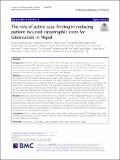Files in this item
The role of active case finding in reducing patient incurred catastrophic costs for tuberculosis in Nepal
Item metadata
| dc.contributor.author | Gurung, Suman Chandra | |
| dc.contributor.author | Dixit, Kritika | |
| dc.contributor.author | Rai, Bhola | |
| dc.contributor.author | Caws, Maxine | |
| dc.contributor.author | Paudel, Puskar Raj | |
| dc.contributor.author | Dhital, Raghu | |
| dc.contributor.author | Acharya, Shraddha | |
| dc.contributor.author | Budhathoki, Gangaram | |
| dc.contributor.author | Malla, Deepak | |
| dc.contributor.author | Levy, Jens W. | |
| dc.contributor.author | van Rest, Job | |
| dc.contributor.author | Lönnroth, Knut | |
| dc.contributor.author | Viney, Kerri | |
| dc.contributor.author | Ramsay, Andrew | |
| dc.contributor.author | Wingfield, Tom | |
| dc.contributor.author | Basnyat, Buddha | |
| dc.contributor.author | Thapa, Anil | |
| dc.contributor.author | Squire, Bertie | |
| dc.contributor.author | Wang, Duolao | |
| dc.contributor.author | Mishra, Gokul | |
| dc.contributor.author | Shah, Kashim | |
| dc.contributor.author | Shrestha, Anil | |
| dc.contributor.author | de Siqueira-Filha, Noemia Teixeira | |
| dc.date.accessioned | 2019-12-06T12:30:04Z | |
| dc.date.available | 2019-12-06T12:30:04Z | |
| dc.date.issued | 2019-12-03 | |
| dc.identifier | 264078498 | |
| dc.identifier | 56de8976-6798-49b5-b267-3dd5169d70e6 | |
| dc.identifier | 85075937007 | |
| dc.identifier | 000500774600003 | |
| dc.identifier.citation | Gurung , S C , Dixit , K , Rai , B , Caws , M , Paudel , P R , Dhital , R , Acharya , S , Budhathoki , G , Malla , D , Levy , J W , van Rest , J , Lönnroth , K , Viney , K , Ramsay , A , Wingfield , T , Basnyat , B , Thapa , A , Squire , B , Wang , D , Mishra , G , Shah , K , Shrestha , A & de Siqueira-Filha , N T 2019 , ' The role of active case finding in reducing patient incurred catastrophic costs for tuberculosis in Nepal ' , Infectious Diseases of Poverty , vol. 8 , 99 . https://doi.org/10.1186/s40249-019-0603-z | en |
| dc.identifier.issn | 2049-9957 | |
| dc.identifier.other | RIS: urn:59488EF2A07EE94807F3223A13D08205 | |
| dc.identifier.other | RIS: Gurung2019 | |
| dc.identifier.uri | https://hdl.handle.net/10023/19084 | |
| dc.description | Stop TB Partnership/UNOPS – TB REACH project (grant number: 5–31); European Union, Horizon 2020 – IMPACT TB project (grant number: 733174). | en |
| dc.description.abstract | Background The World Health Organization (WHO) End TB Strategy has established a milestone to reduce the number of tuberculosis (TB)- affected households facing catastrophic costs to zero by 2020. The role of active case finding (ACF) in reducing patient costs has not been determined globally. This study therefore aimed to compare costs incurred by TB patients diagnosed through ACF and passive case finding (PCF), and to determine the prevalence and intensity of patient-incurred catastrophic costs in Nepal. Methods The study was conducted in two districts of Nepal: Bardiya and Pyuthan (Province No. 5) between June and August 2018. One hundred patients were included in this study in a 1:1 ratio (PCF: ACF, 25 consecutive ACF and 25 consecutive PCF patients in each district). The WHO TB patient costing tool was applied to collect information from patients or a member of their family regarding indirect and direct medical and non-medical costs. Catastrophic costs were calculated based on the proportion of patients with total costs exceeding 20% of their annual household income. The intensity of catastrophic costs was calculated using the positive overshoot method. The chi-square and Wilcoxon-Mann-Whitney tests were used to compare proportions and costs. Meanwhile, the Mantel Haenszel test was performed to assess the association between catastrophic costs and type of diagnosis. Results Ninety-nine patients were interviewed (50 ACF and 49 PCF). Patients diagnosed through ACF incurred lower costs during the pre-treatment period (direct medical: USD 14 vs USD 32, P = 0.001; direct non-medical: USD 3 vs USD 10, P = 0.004; indirect, time loss: USD 4 vs USD 13, P < 0.001). The cost of the pre-treatment and intensive phases combined was also lower for direct medical (USD 15 vs USD 34, P = 0.002) and non-medical (USD 30 vs USD 54, P = 0.022) costs among ACF patients. The prevalence of catastrophic direct costs was lower for ACF patients for all thresholds. A lower intensity of catastrophic costs was also documented for ACF patients, although the difference was not statistically significant. Conclusions ACF can reduce patient-incurred costs substantially, contributing to the End TB Strategy target. Other synergistic policies, such as social protection, will also need to be implemented to reduce catastrophic costs to zero among TB-affected households. | |
| dc.format.extent | 15 | |
| dc.format.extent | 908636 | |
| dc.language.iso | eng | |
| dc.relation.ispartof | Infectious Diseases of Poverty | en |
| dc.subject | Tuberculosis | en |
| dc.subject | Case finding | en |
| dc.subject | Catastrophic cost | en |
| dc.subject | Patient-incurred cost | en |
| dc.subject | Nepal | en |
| dc.subject | RA0421 Public health. Hygiene. Preventive Medicine | en |
| dc.subject | E-DAS | en |
| dc.subject | SDG 1 - No Poverty | en |
| dc.subject | SDG 3 - Good Health and Well-being | en |
| dc.subject.lcc | RA0421 | en |
| dc.title | The role of active case finding in reducing patient incurred catastrophic costs for tuberculosis in Nepal | en |
| dc.type | Journal article | en |
| dc.contributor.institution | University of St Andrews. School of Medicine | en |
| dc.identifier.doi | https://doi.org/10.1186/s40249-019-0603-z | |
| dc.description.status | Peer reviewed | en |
This item appears in the following Collection(s)
Items in the St Andrews Research Repository are protected by copyright, with all rights reserved, unless otherwise indicated.

